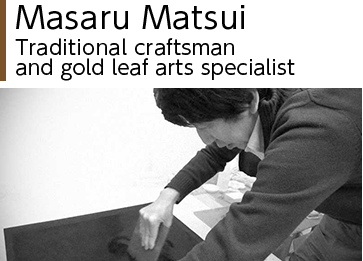Traditional craftsman and gold foil arts specialist Masaru Matsui website | profile


■1961 Born in Nakagyo Ward, Kyoto
■1983 Started learning Hikibaku under the guidance of his uncle Katsuyoshi Takeda, an expert acknowledged by the Kyoto City Traditional Arts industry. Gradually, in learning Hikibaku design and the production process, Masaru became entranced by craftsmanship. Most notably fascinated by Hikibaku using lacquer and gold leaf.
■2004 Registered as a traditional craftsman of the spinning division of Nishijin-ori, designated as a traditional craft by a Minister of Economy, Trade and Industry. Including the Kawashima Selkon Texitiles Co. and Nagashima Sei Texitile companies his Hikibaku works have been adopted for kimono sashes. Performances promoting Hikibaku are held nationwide, demonstrating traditional lacquer and gold leaf application methods.
■2012 Exhibited his Hikibaku works in "DEAGU ART FAIR 2012" in Deagu, Korea, which aimed to share this traditional Japanese art method with people worldwide and create the diversity in Hikibaku.
■2013 Established his own shop Azula. While preserving traditional methods he aims to expand into a multitude of fields including contemporary art.

About Hikibaku
Hikibaku is produced using color urushi or lacquer, with a pattern applied in gold, silver or platinum leaf. This technique is used to create and color Japanese traditional Washi paper (primarily made from Edgeworthia chrysantha) as well as Hikibaku being one of the materials in Nishijin-ori fabrics, particularly for kimono sashes and gold brocade. The process and design has a multitude of variations. Dependent upon an artist’s preferences there is an infinite probability of designs. After completion, 0.3 mm wide strands are cut and woven in succession to produce patterns in textiles. In combination with color thread, Hikibaku woven into sashes create extravagantly patterned designs.



About a craftsman in traditional arts At first, those who have been engaged in manufacturing of traditional crafts designated by a Minister of Economy, Trade and Industry for more than 12 years as well as having lived in the locality of the crafts are nominated. Then, those who have passed written and practical exams conducted by the Industry Promotion Association of Traditional Crafts in accordance with Paragraph 8 of Section 24, Promotion of Traditional Craft Industries; craftspersons are certified in traditional industry arts. Craftspersons are expected to research a production area’s characteristic technique, improve upon their skills and methods, as well as pass them down to the next generation.
At first, those who have been engaged in manufacturing of traditional crafts designated by a Minister of Economy, Trade and Industry for more than 12 years as well as having lived in the locality of the crafts are nominated. Then, those who have passed written and practical exams conducted by the Industry Promotion Association of Traditional Crafts in accordance with Paragraph 8 of Section 24, Promotion of Traditional Craft Industries; craftspersons are certified in traditional industry arts. Craftspersons are expected to research a production area’s characteristic technique, improve upon their skills and methods, as well as pass them down to the next generation.
